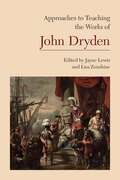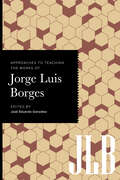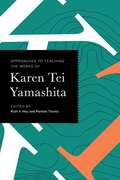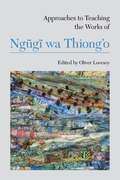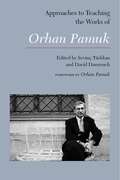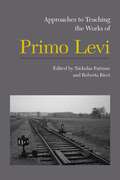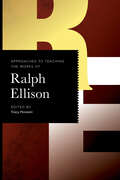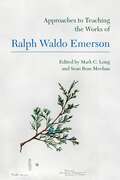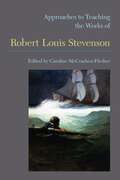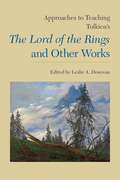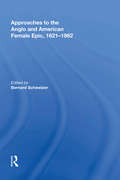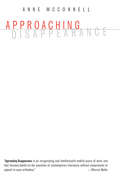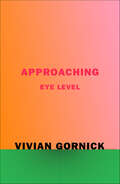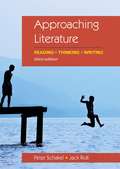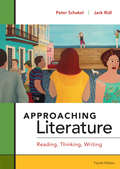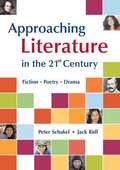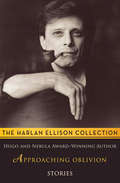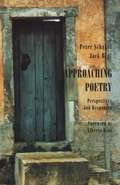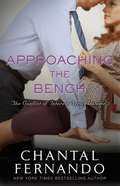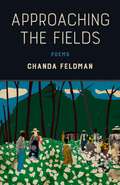- Table View
- List View
Approaches to Teaching the Works of John Dryden (Approaches to Teaching World Literature #126)
by The Modern Language AssociationWhich John Dryden should be brought into the twenty-first-century college classroom? The rehabilitator of the ancients? The first of the moderns? The ambivalent laureate? The sidelined convert to Rome? The literary theorist? The translator? The playwright? The poet? This volume in the MLA series Approaches to Teaching World Literature addresses the tensions, contradictions, and versatility of a writer who, in the words of Samuel Johnson, "found [English poetry] brick, and left it marble," who was, in the words of Walter Scott, "one of the greatest of our masters."Part 1, "Materials," offers a guide to the teaching editions of Dryden's work and a discussion of the background resources, from biographies and literary criticism to social, cultural, political, and art histories. In part 2, "Approaches," essays describe different pedagogical entries into Dryden and his time. These approaches cover subjects as various as genre, adaptation, literary rivalry, musical setting, and political and religious poetry in classroom situations that range from the traditional survey to learning through performance.
Approaches to Teaching the Works of Jorge Luis Borges (Approaches to Teaching World Literature #180)
by José Eduardo GonzálezOften considered a writer who transcends national borders, Jorge Luis Borges also aimed to reinvent the history and traditions of his own country, Argentina. His unconventional works appeal to students, who nonetheless can find his richly intertextual prose challenging. Addressing courses in Spanish and in English, this volume offers innovative approaches that help students navigate the texts, engage with them emotionally and creatively, and understand the time and place of their production while connecting them to the present.Part 1, "Materials," provides detailed biographical information about Borges as well as print and digital resources. The essays in part 2, "Approaches," offer strategies for discussing his writing process, his manuscripts, and the material history and translation of his texts. Contributors also examine Borges's influences, which include film, mythology, history, and ideas of Islam and Judaism; the author's interest in humor and games; and resonances with other literary works.
Approaches to Teaching the Works of Karen Tei Yamashita (Approaches to Teaching World Literature #168)
by Ruth Y. Hsu and Pamela ThomaStructurally innovative and culturally expansive, the works of Karen Tei Yamashita invite readers to rethink conventional paradigms of genres and national traditions. Her novels, plays, and other texts refashion forms like the immigrant tale, the postmodern novel, magical realism, apocalyptic literature, and the picaresque and suggest new transnational, hemispheric, and global frameworks for interpreting Asian American literature.Addressing courses in American studies, contemporary fiction, environmental humanities, and literary theory, the essays in this volume are written by undergraduate and graduate instructors from across the United States and around the globe. Part 1, "Materials," outlines Yamashita's novels and other texts, key works of criticism and theory, and resources for Asian American and Asian Brazilian literature and culture. Part 2, "Approaches," provides options for exploring Yamashita's works through teaching historical debates, outlining principles of environmental justice, mapping geographic boundaries to highlight power dynamics, and drawing personal connections to the texts. Additionally, an essay by Yamashita describes her own approaches to teaching creative writing.
Approaches to Teaching the Works of Miguel de Unamuno (Approaches to Teaching World Literature #164)
by Luis Álvarez-CastroA central figure of Spanish culture and an author in many genres, Miguel de Unamuno (1864-1936) is less well known outside Spain. He was a surprising writer and thinker: a professor of Greek who embraced metafiction and modernist methods, a proponent of Castilian Spanish although born in the Basque Country and influenced by many international writers, and an early existentialist who was yet religious. He found himself in opposition to both King Alfonso XIII and the military dictatorship of Miguel Primo de Rivera and then became involved in the political upheaval that led to the Spanish Civil War.Part 1 of this volume, "Materials," gives information on different editions and translations of Unamuno's works, on scholarly and critical secondary sources, and on Web resources. The essays in part 2, "Approaches," offer suggestions for introducing students to the range of his works--novels, essays, poetry, and drama--in Spanish language and literature, comparative literature, religion, and philosophy classrooms.
Approaches to Teaching the Works of Ngũgĩ wa Thiong'o (Approaches to Teaching World Literature #121)
by Oliver LoveseyNgũgĩ wa Thiong'o is one of the most important and celebrated authors of postindependence Africa as well as a groundbreaking postcolonial theorist. His work, written first in English, then in Gikuyu, engages with the transformations of his native Kenya after what is often termed the Mau Mau rebellion. It also gives voice to the struggles of all Africans against economic injustice and political oppression. His writing and activism have continued despite imprisonment, the threat of assassination, and exile.Part 1 of this volume, "Materials," provides resources and background for the teaching of Ngũgĩ's novels, plays, memoirs, and criticism. The essays of part 2, "Approaches," consider the influence of Frantz Fanon, Karl Marx, and Joseph Conrad on Ngũgĩ; how the role of women in his fiction is inflected by feminism; his interpretation and political use of African history; his experimentation with orality and allegory in narrative; and the different challenges of teaching Ngũgĩ in classrooms in the United States, Europe, and Africa.
Approaches to Teaching the Works of Orhan Pamuk (Approaches to Teaching World Literature #146)
by Sevinç Türkkan and David DamroschWinner of the Nobel Prize in Literature in 2006, Orhan Pamuk is Turkey's preeminent novelist and an internationally recognized figure of letters. Influenced by both Turkish and European literature, his works interrogate problems of modernity and of East and West in the Turkish context and incorporate the Ottoman legacy linguistically and thematically. The stylistic and thematic aspects of his novels, his intriguing use of intertextual elements, and his characters' metatextual commentaries make his work rewarding in courses on world literature and on the postmodern novel. Pamuk's nonfiction writings extend his themes of memory, loss, personal and political histories, and the craft of the novel.Part 1, "Materials," provides biographical background and introduces instructors to translations and critical scholarship that will elucidate Pamuk's works. In part 2, "Approaches," essays cover topics that support teachers in a range of classrooms, including Pamuk's use of the Turkish language, the political background to Pamuk's novels, the politics of translation and aesthetics, and Pamuk's works as world literature.
Approaches to Teaching the Works of Primo Levi (Approaches to Teaching World Literature #133)
by Nicholas Patruno Roberta RicciPrimo Levi, Holocaust survivor and renowned memoirist, is one of the most widely read writers of post-World War II Italy. His works are characterized by the lean, dispassionate eloquence with which he approaches his experience of incarceration in Auschwitz. His memoirs--as well as his poetry and fiction and his many interviews--are often taught in several fields, including Jewish studies and Holocaust studies, comparative literature, and Italian language and literature, and can enrich the study of history, psychology, and philosophy.The first part of this volume provides instructors with an overview of the available editions, anthologies, and translations of Levi's work and identifies other useful classroom aids, such as films, music, and online resources. In the second part, contributors describe different approaches to teaching Levi's work. Some, in presenting Survival in Auschwitz, The Reawakening, and The Drowned and the Saved, look at the place of style in Holocaust testimony and the reliability of memory in autobiography. Others focus on questions of translation, complicated by the untranslatable in the language and experiences of the concentration camps, or on how Levi incorporates his background as a chemist into his writing, most clearly in The Periodic Table.
Approaches to Teaching the Works of Ralph Ellison (Approaches to Teaching World Literature #177)
by Tracy FloreaniOne of the most important American authors and public intellectuals of the twentieth century, Ralph Ellison had a keen and unsentimental understanding of the relationship between race, art, and activism in American life. He contended with other writers of his day in his examination of the entrenched racism in society, and his writing continues to inform national conversations in letters and culture.The essays in Approaches to Teaching the Works of Ralph Ellison will help instructors in colleges, high schools, and prisons teach not only the indispensable Invisible Man but also Ellison's short stories, his essays, and the two editions of his second, unfinished novel, Juneteenth and Three Days before the Shooting . . . . In considering Ellison's works in relation to jazz, technology, humor, politics, queerness, and disability, this volume mirrors the breadth of Ellison's own life, which extended from the Jim Crow era through the Black Power movement.
Approaches to Teaching the Works of Ralph Waldo Emerson (Approaches to Teaching World Literature #155)
by Mark C. Long and Sean Ross MeehanA leader of the transcendentalist movement and one of the country's first public intellectuals, Ralph Waldo Emerson has been a long-standing presence in American literature courses. Today he is remembered for his essays, but in the nineteenth century he was also known as a poet and orator who engaged with issues such as religion, nature, education, and abolition.This volume presents strategies for placing Emerson in the context of his time, for illuminating his rhetorical techniques, and for tracing his influence into the present day and around the world. Part 1, "Materials," offers guidance for selecting classroom editions and information on Emerson's life, contexts, and reception. Part 2, "Approaches," provides suggestions for teaching Emerson's works in a variety of courses, not only literature but also creative writing, religion, digital humanities, media studies, and environmental studies. The essays in this section address Emerson's most frequently anthologized works, such as Nature and "Self-Reliance," along with other texts including sermons, lectures, journals, and poems.
Approaches to Teaching the Works of Robert Louis Stevenson (Approaches to Teaching World Literature #124)
by Caroline McCracken-FlesherAlthough Robert Louis Stevenson was a late Victorian, his work--especially Treasure Island and The Strange Case of Dr. Jekyll and Mr. Hyde--still circulates energetically and internationally among popular and academic audiences and among young and old. Admired by Henry James, Vladimir Nabokov, and Jorge Luis Borges, Stevenson's fiction crosses the boundaries of genre and challenges narrow definitions of the modern and the postmodern.Part 1 of this volume, "Materials," provides an introduction to the writer's life, a survey of the criticism of his work, and a variety of resources for the instructor. In part 2, "Approaches," thirty essays address such topics as Stevenson's dialogue with James about literature; his verse for children; his Scottish heritage; his wanderlust; his work as gothic fiction, as science fiction, as detective fiction; his critique of imperialism in the South Seas; his usefulness in the creative writing classroom; and how Stevenson encourages expansive thinking across texts, times, places, and lives.
Approaches to Teaching the Writings of Emilia Pardo Bazán (Approaches to Teaching World Literature #147)
by Margot Versteeg Susan Walter"Emilia Pardo Bazán (1851-1921) was the most prolific and influential woman writer of late nineteenth-century Spain," write the editors of this volume in the MLA's Approaches to Teaching World Literature series. Contending with the critical literary, cultural, and social issues of the period, Pardo Bazán's novels, novellas, short stories, essays, plays, travel writing, and cookbooks offer instructors countless opportunities to engage with a variety of critical frameworks. The wide range of topics in the author's works, from fashion to science and technology to gender equality, and the brilliance of her literary style make Pardo Bazán a compelling figure in the classroom.Part 1, "Materials," provides biographical and critical resources, an overview of Pardo Bazán's vast and diverse oeuvre, and a literary-historical time line. It also reviews secondary sources, editions and translations, and digital resources. The twenty-three essays in part 2, "Approaches," explore various issues that are central to teaching Pardo Bazán's works, including the author's engagement with contemporary literary movements, feminism and gender, nation and the late Spanish empire, Spanish and Galician identities, and nineteenth-century scientific and medical discourses. Film adaptations and translations of Pardo Bazán's works are also addressed. Highlighting the artistic, social, and intellectual currents of Pardo Bazán's writings, this volume will assist instructors who wish to teach the author's works in courses on world literature, nineteenth-century literature, and gender studies as well as in Spanish-language courses.
Approaches to Teaching Tolkien's The Lord of the Rings and Other Works (Approaches to Teaching World Literature #136)
by The Modern Language Association of AmericaA philologist and medieval scholar, J. R. R. Tolkien never intended to write immensely popular literature that would challenge traditional ideas about the nature of great literature and that was worthy of study in colleges across the world. He set out only to write a good story, the kind of story he and his friends would enjoy reading. In The Hobbit and in The Lord of the Rings, Tolkien created an entire world informed by his vast knowledge of mythology, languages, and medieval literature. In the 1960s, his books unexpectedly gained cult status with a new generation of young, countercultural readers. Today, the readership for Tolkien's absorbing secondary world--filled with monsters, magic, adventure, sacrifice, and heroism--continues to grow.Part 1 of this volume, "Materials," introduces instructors to the rich array of resources available for teaching Tolkien, including editions and criticism of his fiction and scholarship, historical material on his life and times, audiovisual materials, and film adaptations of his fiction. The essays in part 2, "Approaches," help instructors introduce students to critical debates around Tolkien's work, its sources, its influence, and its connection to ecology, religion, and science. Contributors draw on interdisciplinary approaches to outline strategies for teaching Tolkien in a wide variety of classroom contexts.
Approaches to the Anglo and American Female Epic, 1621-1982
by Bernard SchweizerEpic has long been regarded as the exclusive domain of the male literary genius and as an incarnation of patriarchal values. This provocative collection of essays challenges such a hegemonic stereotype by demonstrating the ways in which women writers have successfully adapted the masculine epic tradition to suit their own aesthetic needs and to express their own heroic literary, social, and historical visions. Bringing the female epic out of the shadows, the contributors rethink generic boundaries to illuminate this heretofore hidden literary practice. The essays range from Mary Tighe to Rebecca West from Elizabeth Barrett Browning to Gwendolyn Brooks, and from Frances Burney to Virginia Woolf. Bernard Schweizer's introduction, titled 'Muses with Pens,' connects the trajectory of ideas and influences in the individual essays to demonstrate how each participates in reclaiming for women writers a place in the development of a female epic tradition. The volume will be an invaluable resource for scholars working on issues related to genre, canon formation, and the evolution of female literary authority.
Approaching Disappearance
by Anne McconnellMaurice Blanchot (1907-2003), one of the most influential figures of twentieth-century French literature, produced a wide variety of essays and fictions that reflect on the complexities of literary work. His description of writing continually returns to a number of themes, such as solitude, passivity, indifference, anonymity, and absence--forces confronting the writer, but also the reader, the text itself, and the relations between the three. For Blanchot, literature involves a movement toward disappearance, where one risks the loss of self; but such a sacrifice, says Blanchot, is inherent in the act of writing. Approaching Disappearance explores the question of disappearance in Blanchot's critical work and then turns to five narratives that offer a unique reflection on the threat of disappearance and the demands of literature--work by Franz Kafka, Jorge Luis Borges, Louis-René Des Forêts, and Nathalie Sarraute.
Approaching Disappearance
by Anne McconnellMaurice Blanchot (1907-2003), one of the most influential figures of twentieth-century French literature, produced a wide variety of essays and fictions that reflect on the complexities of literary work. His description of writing continually returns to a number of themes, such as solitude, passivity, indifference, anonymity, and absence--forces confronting the writer, but also the reader, the text itself, and the relations between the three. For Blanchot, literature involves a movement toward disappearance, where one risks the loss of self; but such a sacrifice, says Blanchot, is inherent in the act of writing. Approaching Disappearance explores the question of disappearance in Blanchot's critical work and then turns to five narratives that offer a unique reflection on the threat of disappearance and the demands of literature--work by Franz Kafka, Jorge Luis Borges, Louis-René Des Forêts, and Nathalie Sarraute.
Approaching Eye Level
by Vivian GornickFrom an acclaimed feminist writer, essays on “loneliness . . . [the] limitations on friendship and intimacy, [honoring] the process of becoming oneself” (Mary Hawthorne, The New York Times Book Review).Seminal essays on loneliness, living in New York, friendship, feminism, and writing from nonfiction master Vivian Gornick.Vivian Gornick’s Approaching Eye Level is a brave collection of personal essays that finds a quintessentially contemporary woman (urban, single, feminist) trying to observe herself and the world without sentiment, cynicism, or nostalgia. Whether walking along the streets of New York or teaching writing at a university, Gornick is a woman exploring her need for conversation and connection—with men and women, colleagues and strangers. She recalls her stint as a waitress in the Catskills and a failed friendship with an older woman and mentor, and reconsiders her experiences in the feminist movement, while living alone, and in marriage.Turning her trademark sharp eye on herself, Gornick works to see her part in things—how she has both welcomed and avoided contact, and how these attempts at connections have enlivened and, at times, defeated her. First published in 1996, Approaching Eye Level is an unrelentingly honest collection of essays that finds Gornick at her best, reminding us that we can come to know ourselves only by engaging fully with the world.“Gripping.” —Library Journal“Gornick bravely faces—and, even more remarkable, clearly renders—loneliness and the ongoing search for human connection. . . . Her prose is sharp and her characterizations—of her friends, modern life, and of herself—ring true.” —Kirkus Reviews
Approaching Literature: Reading + Thinking + Writing (Third Edition)
by Peter Schakel Jack RidlThe central aim of this book is to foster habits and skills of critical thinking. The third edition makes the book even more inclusive and accessible than the first and second editions. A unique feature of this book is its appendix on reading critical essays, which provides practical instruction on how to approach and read the academic essay, a genre that in itself is unfamiliar to many students, and which students may be asked to use as sources in their own writing.
Approaching Literature (Fourth Edition): Reading, Thinking, Writing
by Peter Schakel Jack RidlApproaching Literature has been designed to give even reluctant students a comfortable way in to literature. The authors Peter Schakel and Jack Ridl set out to use contemporary literary works as entry points to canonical literature and to make the instruction in reading and writing welcoming and accessible to all students, not just potential English majors. With its affordable price, its streamlined and student-friendly text and its commitment to showcasing the most engaging and diverse literary works publishing right now, all students will find something in Approaching Literature that allows them to experience meaningful immersion into the world of literature.
Approaching Literature in the 21st Century: Fiction, Poetry, Drama
by Peter Schakel Jack RidlNIMAC-sourced textbook
Approaching Oblivion: Road Signs on the Treadmill Toward Tomorrow
by Harlan EllisonThe New York Times called him "relentlessly honest" and then used him as the subject of its famous Sunday Acrostic. People Magizine said there was no one like him, then cursed him for preventing easy sleep. But in these stories Harlan Ellison outdoes himself, rampaging like a mad thing through love ("Cold Friend", "Kiss of Fire", "Paulie Charmed the Sleeping Woman"), hate ("Knox", "Silent in Gehenna"), sex ("Catman", "Erotophobia"), lost childhood ("One Life, Furnished in Early Poverty") and into such bizarre subjects as the problems of blue-skinned, eleven-armed Yiddish aliens, what it's like to witness the end of the world and what happens on the day the planet Earth swallows Barbra Streisand. Oh yeah, this one's a doozy!
Approaching Oblivion: Stories
by Harlan EllisonOver the course of his legendary career, Harlan Ellison has defied--and sometimes defined--modern fantasy literature, all while refusing to allow any genre to claim him. A Grand Master of the Science Fiction Writers of America, winner of the Lifetime Achievement Award from the Horror Writers Association, as well as winner of countless awards, including the Hugo, Nebula, Edgar Allan Poe, and Bram Stoker, Ellison is as unpredictable as he is unique, irrepressible as he is infuriating. Over thirty titles in Ellison's brilliant catalog are now available in an elegant new package featuring Ellison himself. Genius never felt so combustible. The New York Times called him "relentlessly honest" and then used him as the subject of its famous Sunday Acrostic. People said there was no one like him, then cursed him for preventing easy sleep. But in these stories, Harlan Ellison outdoes himself, rampaging like a mad thing through love ("Cold Friend," "Kiss of Fire," "Paulie Charmed the Sleeping Woman"), hate ("Knox," "Silent in Gehenna"), sex ("Catman," "Erotophobia"), lost childhood ("One Life, Furnished in Early Poverty"), and into such bizarre subjects as the problems of blue-skinned, eleven-armed Yiddish aliens, what it is like to witness the end of the world, and what happens on the day the planet Earth swallows Barbra Streisand. Oh yeah, this one is a doozy!
Approaching Poetry: Perspectives and Responses
by Jack Ridl Peter SchakelThis wide-ranging introduction to poetry blends theoretical considerations with a thorough introduction to the elements of poetry, offering alternative perspectives from which to approach and engage with a poem.
The Approaching Storm (Star Wars)
by Alan Dean FosterThis novel takes place just before Attack of the Clones.
Approaching the Bench (The Conflict of Interest Series #3)
by Chantal FernandoA tenacious, resilient female judge must find a way to work with her carefree clerk as they find themselves in danger when a fugitive sets his sights on revenge in the third book in New York Times bestselling author Chantal Fernando’s sexy and thrilling Conflict of Interest Series.Trinity Williams, known as “Medusa” for her stony expressions and unyielding reputation, constantly has her guard up—how else is the youngest female judge in the country supposed to survive in such a male-dominated profession? She made the decision long ago that laughter and a carefree attitude have no business in a courtroom and achieving her professional goals is the only thing she has left. It’s just her luck that her new law clerk, Callum Hopkins, believes the exact opposite. Callum Hopkins thinks that nothing should ever be too serious in life—why can’t he mix business with pleasure? When he first starts working for his hot new boss, they clash at every turn. He makes it his mission to get Judge Williams to see things his way for once. But when Callum finds himself in the wrong place at the wrong time as an escaped convict comes after Trinity, he realizes it’s not all fun and games anymore. Now in witness protection together until the authorities can catch the fugitive, this unlikely pair must learn to trust one another and work together to stay alive. Far away from the courtroom, Trinity and Callum are suddenly free to stop butting heads, and stop fighting the growing attraction between them. With suspense and plenty of chemistry, Approaching the Bench proves once again that “Chantal Fernando knows how to draw you in and keep you hooked” (Booklist).
Approaching the Fields: Poems
by Chanda FeldmanElegiac and fierce, solemn and celebratory, the poems in Chanda Feldman’s Approaching the Fields consider family and history. From black sharecroppers and subsistence farmers along the Mississippi River to contemporary life in the suburbs, the rituals of home and work link racial experience, social lines, and economic striving, rooting memory and scene in the southern landscape. Love and violence echo through the collection, and Feldman’s beautifully crafted poems, often formal in style, answer them sometimes with an embrace and sometimes with a turning away. She witnesses the crop fields and manicured lawns, the dinner table and birthing room, the church and juke joint, conveying the ways that everyday details help build a life.These evocative poems bring to life a rich and complex world, both timely and timeless.
